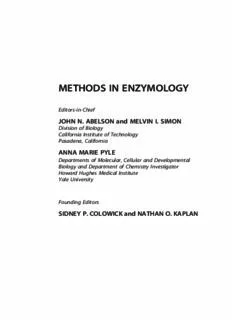Table Of ContentMETHODS IN ENZYMOLOGY
Editors-in-Chief
JOHN N. ABELSON and MELVIN I. SIMON
Division of Biology
California Institute of Technology
Pasadena, California
ANNA MARIE PYLE
Departments of Molecular, Cellular and Developmental
Biology and Department of Chemistry Investigator
Howard Hughes Medical Institute
Yale University
Founding Editors
SIDNEY P. COLOWICK and NATHAN O. KAPLAN
AcademicPressisanimprintofElsevier
525BStreet,Suite1800,SanDiego,CA92101-4495,USA
225WymanStreet,Waltham,MA02451,USA
32JamestownRoad,LondonNW17BY,UK
TheBoulevard,LangfordLane,Kidlington,Oxford,OX51GB,UK
Firstedition2014
Copyright©2014ElsevierInc.Allrightsreserved.
Nopartofthispublicationmaybereproducedortransmittedinanyformorbyanymeans,
electronicormechanical,includingphotocopying,recording,oranyinformationstorageand
retrievalsystem,withoutpermissioninwritingfromthepublisher.Detailsonhowtoseek
permission,furtherinformationaboutthePublisher’spermissionspoliciesandour
arrangementswithorganizationssuchastheCopyrightClearanceCenterandtheCopyright
LicensingAgency,canbefoundatourwebsite:www.elsevier.com/permissions.
Thisbookandtheindividualcontributionscontainedinitareprotectedundercopyrightby
thePublisher(otherthanasmaybenotedherein).
Notices
Knowledgeandbestpracticeinthisfieldareconstantlychanging.Asnewresearchand
experiencebroadenourunderstanding,changesinresearchmethods,professionalpractices,
ormedicaltreatmentmaybecomenecessary.
Practitionersandresearchersmustalwaysrelyontheirownexperienceandknowledgein
evaluatingandusinganyinformation,methods,compounds,orexperimentsdescribed
herein.Inusingsuchinformationormethodstheyshouldbemindfuloftheirownsafetyand
thesafetyofothers,includingpartiesforwhomtheyhaveaprofessionalresponsibility.
Tothefullestextentofthelaw,neitherthePublishernortheauthors,contributors,oreditors,
assumeanyliabilityforanyinjuryand/ordamagetopersonsorpropertyasamatterof
productsliability,negligenceorotherwise,orfromanyuseoroperationofanymethods,
products,instructions,orideascontainedinthematerialherein.
ISBN:978-0-12-801185-0
ISSN:0076-6879
ForinformationonallAcademicPresspublications
visitourwebsiteatstore.elsevier.com
CONTRIBUTORS
CarolinAnders
DepartmentofBiochemistry,UniversityofZurich,Zurich,Switzerland
CarlosF.BarbasIII
DepartmentofChemistry,andDepartmentofCellandMolecularBiology,TheSkaggs
InstituteforChemicalBiology,TheScrippsResearchInstitute,LaJolla,California,USA
IraL.Blitz
DepartmentofDevelopmentalandCellBiology,UniversityofCalifornia,Irvine,California,
USA
ErikaBrunet
MuseumNationald’HistoireNaturelle,INSERMU1154,CNRS7196,Paris,France
SusanM.Byrne
DepartmentofGenetics,HarvardMedicalSchool,Boston,Massachusetts,USA
JamieH.D.Cate
EnergyBiosciencesInstitute;DepartmentofMolecularandCellBiology;Departmentof
Chemistry,UniversityofCalifornia,andPhysicalBiosciencesDivision,LawrenceBerkeley
NationalLaboratory,Berkeley,California,USA
ReginaCencic
DepartmentofBiochemistry,McGillUniversity,Montreal,Quebec,Canada
BaohuiChen
DepartmentofPharmaceuticalChemistry,UniversityofCalifornia,SanFrancisco,
California,USA
KenW.Y.Cho
DepartmentofDevelopmentalandCellBiology,UniversityofCalifornia,Irvine,California,
USA
GeorgeM.Church
DepartmentofGenetics,HarvardMedicalSchool,Boston,Massachusetts,USA
ChadA.Cowan
DepartmentofStemCellandRegenerativeBiology,HarvardUniversity;HarvardStemCell
Institute,ShermanFairchildBiochemistry,Cambridge,andCenterforRegenerative
Medicine,MassachusettsGeneralHospital,Boston,Massachusetts,USA
D.Dambournet
DepartmentofMolecularandCellBiology,UniversityofCalifornia,Berkeley,California,
USA
D.G.Drubin
DepartmentofMolecularandCellBiology,UniversityofCalifornia,Berkeley,California,
USA
xiii
xiv Contributors
LeonardoM.R.Ferreira
DepartmentofStemCellandRegenerativeBiology,HarvardUniversity,Cambridge,
Massachusetts,USA
MargaretB.Fish
DepartmentofDevelopmentalandCellBiology,UniversityofCalifornia,Irvine,California,
USA
YanfangFu
MolecularPathologyUnit,CenterforComputationalandIntegrativeBiology,andCenter
forCancerResearch,MassachusettsGeneralHospital,Charlestown,andDepartmentof
Pathology,HarvardMedicalSchool,Boston,Massachusetts,USA
YoshitakaFujihara
ResearchInstituteforMicrobialDiseases,OsakaUniversity,Suita,Japan
ThomasGaj
DepartmentofChemistry,andDepartmentofCellandMolecularBiology,TheSkaggs
InstituteforChemicalBiology,TheScrippsResearchInstitute,LaJolla,California,USA
HindGhezraoui
MuseumNationald’HistoireNaturelle,INSERMU1154,CNRS7196,Paris,France
AndrewP.W.Gonzales
CardiovascularResearchCenter,MassachusettsGeneralHospital,Charlestown,and
DepartmentofMedicine,HarvardMedicalSchool,Boston,Massachusetts,USA
FedericoGonza´lez
DevelopmentalBiologyProgram,Sloan-KetteringInstitute,NewYork,USA
RobertM.Grainger
DepartmentofBiology,UniversityofVirginia,Charlottesville,Virginia,USA
A.Grassart
DepartmentofMolecularandCellBiology,UniversityofCalifornia,Berkeley,California,
USA
YutingGuan
ShanghaiKeyLaboratoryofRegulatoryBiology,InstituteofBiomedicalSciencesand
SchoolofLifeSciences,EastChinaNormalUniversity,Shanghai,China
JohnP.Guilinger
DepartmentofChemistry&ChemicalBiology,andHowardHughesMedicalInstitute,
HarvardUniversity,Cambridge,Massachusetts,USA
S.H.Hong
DepartmentofMolecularandCellBiology,UniversityofCalifornia,Berkeley,California,
USA
BenjaminE.Housden
DepartmentofGenetics,HarvardMedicalSchool,Boston,Massachusetts,USA
BoHuang
DepartmentofPharmaceuticalChemistry,andDepartmentofBiochemistryandBiophysics,
UniversityofCalifornia,SanFrancisco,California,USA
Contributors xv
DanweiHuangfu
DevelopmentalBiologyProgram,Sloan-KetteringInstitute,NewYork,USA
MasahitoIkawa
ResearchInstituteforMicrobialDiseases,OsakaUniversity,Suita,Japan
RayelleItouaMa¨ıga
DepartmentofBiochemistry,McGillUniversity,Montreal,Quebec,Canada
MariaJasin
DevelopmentalBiologyProgram,MemorialSloan-KetteringCancerCenter,NewYork,
USA
MartinJinek
DepartmentofBiochemistry,UniversityofZurich,Zurich,Switzerland
J.KeithJoung
MolecularPathologyUnit,CenterforComputationalandIntegrativeBiology,andCenter
forCancerResearch,MassachusettsGeneralHospital,Charlestown,andDepartmentof
Pathology,HarvardMedicalSchool,Boston,Massachusetts,USA
AlexandraKatigbak
DepartmentofBiochemistry,McGillUniversity,Montreal,Quebec,Canada
HyongbumKim
GraduateSchoolofBiomedicalScienceandEngineering,CollegeofMedicine,Hanyang
University,Seoul,SouthKorea
Jin-SooKim
CenterforGenomeEngineering,InstituteforBasicScience,andDepartmentofChemistry,
SeoulNationalUniversity,Seoul,SouthKorea
Young-HoonKim
GraduateSchoolofBiomedicalScienceandEngineering,CollegeofMedicine,Hanyang
University,Seoul,SouthKorea
PrzemekM.Krawczyk
DevelopmentalBiologyProgram,MemorialSloan-KetteringCancerCenter,NewYork,
USA,andDepartmentofCellBiologyandHistology,AcademicMedicalCenter,University
ofAmsterdam,Amsterdam,TheNetherlands
DaliLi
ShanghaiKeyLaboratoryofRegulatoryBiology,InstituteofBiomedicalSciencesand
SchoolofLifeSciences,EastChinaNormalUniversity,Shanghai,China
Jian-FengLi
DepartmentofMolecularBiology,CentreforComputationalandIntegrativeBiology,
MassachusettsGeneralHospital,andDepartmentofGenetics,HarvardMedicalSchool,
Boston,Massachusetts,USA
ShuailiangLin
DepartmentofGenetics,HarvardMedicalSchool,Boston,Massachusetts,USA
xvi Contributors
DavidR.Liu
DepartmentofChemistry&ChemicalBiology,andHowardHughesMedicalInstitute,
HarvardUniversity,Cambridge,Massachusetts,USA
MingyaoLiu
ShanghaiKeyLaboratoryofRegulatoryBiology,InstituteofBiomedicalSciencesand
SchoolofLifeSciences,EastChinaNormalUniversity,Shanghai,China
PrashantMali
DepartmentofGenetics,HarvardMedicalSchool,Boston,Massachusetts,USA
AbbaMalina
DepartmentofBiochemistry,McGillUniversity,Montreal,Quebec,Canada
PankajK.Mandal
DepartmentofStemCellandRegenerativeBiology,HarvardUniversity,Cambridge,and
PrograminCellularandMolecularMedicine,DivisionofHematology/Oncology,Boston
Children’sHospital,Boston,Massachusetts,USA
SumanthManohar
DepartmentofBiology,UniversityofVirginia,Charlottesville,Virginia,USA
TorstenB.Meissner
DepartmentofStemCellandRegenerativeBiology,HarvardUniversity,Cambridge,
Massachusetts,USA
HisashiMiura
DepartmentofBiochemistry,McGillUniversity,Montreal,Quebec,Canada
DanaC.Nadler
DepartmentofChemicalandBiomolecularEngineering,UniversityofCalifornia,Berkeley,
California,USA
TakuyaNakayama
DepartmentofBiology,UniversityofVirginia,Charlottesville,Virginia,USA
BenjaminL.Oakes
DepartmentofMolecular&CellBiology,UniversityofCalifornia,Berkeley,California,
USA
AkinleyeO.Odeleye
DepartmentofBiology,UniversityofVirginia,Charlottesville,Virginia,USA
VikramPattanayak
DepartmentofPathology,MassachusettsGeneralHospital,Boston,Massachusetts,USA
JerryPelletier
DepartmentofBiochemistry;DepartmentofOncology,andTheRosalindandMorris
GoodmanCancerResearchCenter,McGillUniversity,Montreal,Quebec,Canada
NorbertPerrimon
DepartmentofGenetics,andHowardHughesMedicalInstitute,HarvardMedicalSchool,
Boston,Massachusetts,USA
Contributors xvii
MarionPiganeau
MuseumNationald’HistoireNaturelle,INSERMU1154,CNRS7196,Paris,France
BenjaminRenouf
MuseumNationald’HistoireNaturelle,INSERMU1154,CNRS7196,Paris,France
DeepakReyon
MolecularPathologyUnit,CenterforComputationalandIntegrativeBiology,andCenter
forCancerResearch,MassachusettsGeneralHospital,Charlestown,andDepartmentof
Pathology,HarvardMedicalSchool,Boston,Massachusetts,USA
FrancisRobert
DepartmentofBiochemistry,McGillUniversity,Montreal,Quebec,Canada
DerrickJ.Rossi
DepartmentofStemCellandRegenerativeBiology,HarvardUniversity,Cambridge;
PrograminCellularandMolecularMedicine,DivisionofHematology/Oncology,Boston
Children’sHospital;DepartmentofPediatrics,HarvardMedicalSchool,Boston,and
HarvardStemCellInstitute,ShermanFairchildBiochemistry,Cambridge,Massachusetts,
USA
OwenW.Ryan
EnergyBiosciencesInstitute,UniversityofCalifornia,Berkeley,California,USA
DavidF.Savage
DepartmentofMolecular&CellBiology;DepartmentofChemistry,andEnergy
BiosciencesInstitute,UniversityofCalifornia,Berkeley,California,USA
HillelT.Schwartz
DivisionofBiologyandBiologicalEngineering,CaliforniaInstituteofTechnology,and
HowardHughesMedicalInstitute,Pasadena,California,USA
YanjiaoShao
ShanghaiKeyLaboratoryofRegulatoryBiology,InstituteofBiomedicalSciencesand
SchoolofLifeSciences,EastChinaNormalUniversity,Shanghai,China
JenSheen
DepartmentofMolecularBiology,CentreforComputationalandIntegrativeBiology,
MassachusettsGeneralHospital,andDepartmentofGenetics,HarvardMedicalSchool,
Boston,Massachusetts,USA
MinjungSong
GraduateSchoolofBiomedicalScienceandEngineering,CollegeofMedicine,Hanyang
University,Seoul,SouthKorea
PaulW.Sternberg
DivisionofBiologyandBiologicalEngineering,CaliforniaInstituteofTechnology,and
HowardHughesMedicalInstitute,Pasadena,California,USA
AlexandroE.Trevino
BroadInstituteofMITandHarvard,7CambridgeCenter;McGovernInstituteforBrain
Research;DepartmentofBrainandCognitiveSciences,andDepartmentofBiological
Engineering,MassachusettsInstituteofTechnology,Cambridge,Massachusetts,USA
xviii Contributors
LianneE.M.Vriend
DevelopmentalBiologyProgram,MemorialSloan-KetteringCancerCenter,NewYork,
USA,andDepartmentofCellBiologyandHistology,AcademicMedicalCenter,University
ofAmsterdam,Amsterdam,TheNetherlands
Jing-RueyJoannaYeh
CardiovascularResearchCenter,MassachusettsGeneralHospital,Charlestown,and
DepartmentofMedicine,HarvardMedicalSchool,Boston,Massachusetts,USA
DandanZhang
DepartmentofMolecularBiology,CentreforComputationalandIntegrativeBiology,
MassachusettsGeneralHospital,andDepartmentofGenetics,HarvardMedicalSchool,
Boston,Massachusetts,USA
FengZhang
BroadInstituteofMITandHarvard,7CambridgeCenter;McGovernInstituteforBrain
Research;DepartmentofBrainandCognitiveSciences,andDepartmentofBiological
Engineering,MassachusettsInstituteofTechnology,Cambridge,Massachusetts,USA
ZengrongZhu
DevelopmentalBiologyProgram,Sloan-KetteringInstitute,NewYork,USA
PREFACE
The availability of whole-genome sequencing data for large numbers and
types of organisms including humans holds exciting promise for advancing
bothresearchandhealthcare.Amajorchallengehasbeenunderstandingand
using genomic data through targeted manipulation of cellular DNA. Ever
sincethediscoveryofDNAstructureinthe1950s,researchersandclinicians
have been contemplating the possibility of making site-specific changes to
thegenomesofcellsandorganisms.Manyoftheearliestapproachestowhat
hasbecomeknownasgenomeeditingreliedontheprincipleofsite-specific
recognitionofDNAsequences.ThestudyofnaturalDNArepairpathways
in bacteria and yeast, as well as the mechanisms of DNA recombination,
showedthatcellshaveendogenousmachinerytorepairDNAdouble-strand
breaks that would otherwise be lethal. Thus, methods for introducing pre-
cisebreaksintheDNAatdesirededitingsiteswererecognizedasavaluable
strategy for targeted genomic engineering.
Althoughsomeisolatedsuccesseswereachievedusingoligonucleotidesor
small molecules to localize DNA-cleaving activities to specific sequences,
proteinsthatcouldbeprogrammedtobindandcleaveparticularDNAsites
proved more broadly useful. Modular DNA recognition proteins, when
coupled to the sequence-independent nuclease domain of the restriction
enzymeFokI,couldfunctionassite-specificnucleases.Whendesignedtorec-
ognizeachromosomalsequence,suchzinc-fingernucleasesandTALeffector
nucleasescanbeeffectiveatinducinggenomicsequencechangesinbothani-
mal and plant cells. Difficulties of protein design, synthesis, and validation
havelimitedwidespreadadoptionoftheseengineerednucleasesforroutine
use,pavingthewayfortheCRISPR/Cas9systeminwhichanaturalprotein
with double-stranded DNA-cleaving activity can be programmed with a
short RNA sequence to recognize and cut DNA sites of interest. The ease
of use, efficiency, and multiplexing capabilities of this technology have
enabledrapidadoptionformanydifferentgenomeengineeringapplications.
Inthisvolume,weprovidereaderswithacollectionofprotocolsforthe
majorprotein-basedgenomeeditingtechniques,withaparticularemphasis
xix
xx Preface
on the more recently developed CRISPR/Cas9 approaches. As these sys-
tems are used more widely and for ever-increasing types of projects, we
anticipatethatthefacilityofgenomemanipulationforapplicationinhuman
health and biotechnology will continue to expand.
JENNIFER A. DOUDNA
ERIK J. SONTHEIMER
Description:This new volume of Methods in Enzymology continues the legacy of this premier serial with quality chapters authored by leaders in the field. This volume covers recent research and methods development for changing the DNA sequence within the genomes of cells and organisms. Focusing on enzymes that ge

